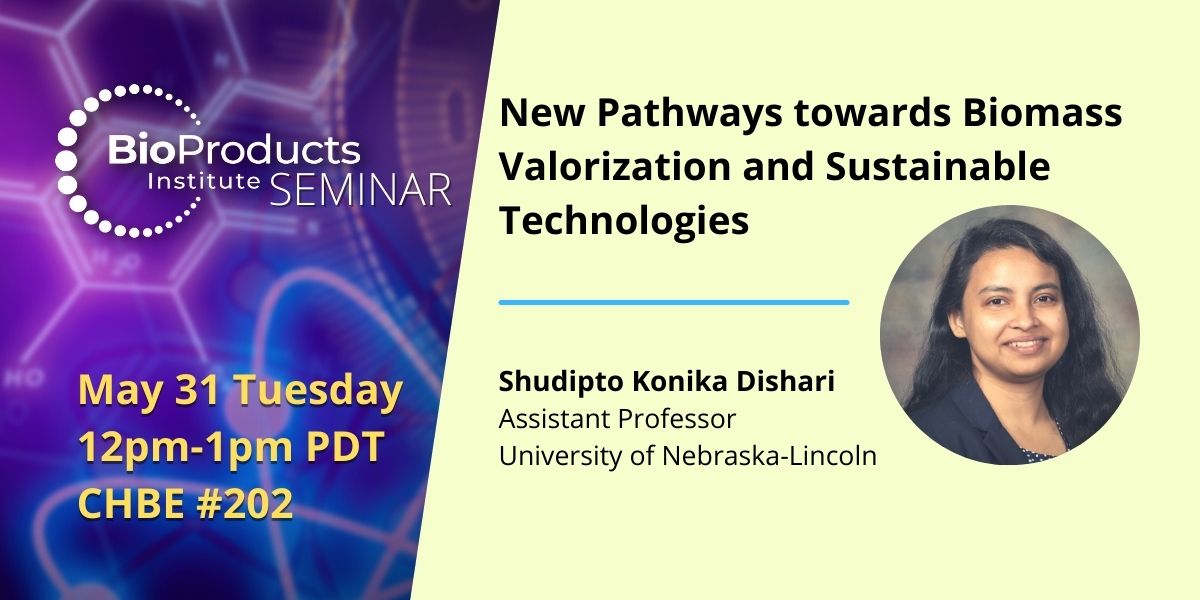BPI Seminar by Dr. Dishari
May 31, 2022, 12:00 am to 12:00 am
TITLE
New Pathways towards Biomass Valorization and Sustainable Technologies
DATE & TIME
May 31st Tuesday 12PM-1PM PDT
LOCATION
CHBE Room 202, 2360 East Mall, Vancouver, BC V6T 1Z3 (Sorry no Zoom link, In-person Only)
ABOUT THE EVENT
In this seminar, Prof. Dishari will discuss new ionomer formulations which can make the ion conduction at electrode interface faster, at the same time, are cost-competitive, and eco-friendly. She will also discuss how this could impact next-generation designs of lignin-based ionomers for energy conversion and storage devices through the use of un-tapped industrial/agricultural lignin-rich wastes.
Refreshments will be provided.
AGENDA
- Introduction by Dr. Orlando Rojas, UBC
- Keynote Presentation by Dr. Shudipto Dishari, University of Nebraska-Lincoln
- Q&A / Discussion moderated by Dr. Feng Jiang, UBC
ABOUT THE SPEAKER
Dr. Shudipto Konika Dishari is an assistant professor in the Department of Chemical and Biomolecular Engineering at the University of Nebraska-Lincoln (UNL). Dishari worked as a post-doctoral fellow in Chemical Engineering (PI: Andrew Zydney) and Materials Science and Engineering (PI: Michael Hickner) at the Pennsylvania State University. Her research is focused on designing synthetic and bio-derived, ion-conducting, and light-harvesting polymers and exploring their nanoscale properties. Dishari’s work aims to impact energy conversion/storage devices, chemical/biosensing, antimicrobial, and bioseparation applications.
Dishari is soon to become an associate professor at UNL. She is the recipient of several honours/awards in recognition of her research and teaching excellence, which includes the Department of Energy (DOE) Office of Science Early CAREER Award (2019), National Science Foundation (NSF) CAREER Award (2018), 3M Non-Tenured Faculty Award (2021), Edgerton Innovation Award (2021), Emerging Innovator of the Year Award by NUTech Venture (2020), Harold and Esther Edgerton Junior Faculty Award (2019), Henry Y. Kleinkauf Family Distinguished New Faculty Teaching Award (2020), Baxter Young Investigator Award (2014) and more.She is currently actively involved in UNL's “Complete Engineering Initiative,” “Diversity and Inclusion Taskforce,” and Nebraska Center for Materials and Nanoscience’s “Education and Outreach Committee”.
ABSTRACT
To excel in sustainable energy technologies (e.g., fuel cells, electrolyzers), we need to address the scientific challenges of these technologies through cutting-edge materials research. Ion-conducting polymers (ionomers) play a critical role in conducting ions from one electrode to another in these electrochemical devices. However, the current state-of-the-art ionomers (such as Nafion) utilized in devices, like hydrogen fuel cells, often experience ion transport limitation at catalyst binder layer of cathode. The poor proton transport at ionomer-catalyst interfaces can make the oxygen reduction reaction at the cathode sluggish. Not only that, due to the fluorocarbon-type backbone, Nafion is expensive and not environment friendly. We thus need new ionomer formulations which can make the ion conduction at electrode interface faster, at the same time, are cost-competitive, and eco-friendly. Converting the untapped, industrial/agricultural lignin-rich wastes to design efficient, cost-effective ionomeric materials for eco-friendly electrochemical devices can aid in bio- and energy economies simultaneously. The major application of lignin in sustainable energy materials has so far been activated, hierarchically porous carbon materials for charge storage and electron conduction in electrodes of batteries/supercapacitors. We attempted to synthesize proton-conducting ionomers using lignin from a range of plant-based sources. These ionomers leverage the hyperbranched, 3-dimensional structure of lignin and controlled degree of sulfonation to facilitate ion conduction under thin-film confinement. To understand the ion transport mechanism, we thoroughly studied the nanoscale self-assembly, ionic domain characteristics, and hydration nature of lignin-based ionomers in thin films (< 1 µm thick) as well as in bulk membranes (up to 50 µm thick). These insights can critically guide the next-generation designs of lignin-based low-cost, but efficient ionomers for energy conversion and storage devices.
